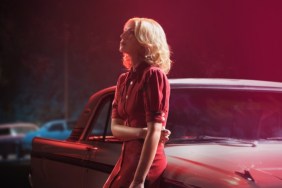&otCast:
Christian Bale as Jack Rollins/Pastor John
Cate Blanchett as Jude Quint
Marcus Carl Franklin as Woody
Richard Gere as Bob Dylan / Billy
Heath Ledger as Robbie
Ben Whishaw as Arthur
David Cross as Allen Ginsberg
Charlotte Gainsbourg as Claire
Garth Gilker as Woody Guthrie
Bruce Greenwood as Keenan Jones/Pat Garrett
Julianne Moore as Alice
Michelle Williams as Coco Rivington
Directed by Todd Haynes
Summary:
Todd Haynes has created a masterpiece of music, words and images; while it may not be the easiest path into the mind and music of Bob Dylan, it’s a vivid portrait of the musical icon that should get even the staunchest Dylan-haters interested in learning more about the man.
Story:
The “music and many lives” of Bob Dylan is interpreted by filmmaker Todd Haynes (“Far from Heaven”), telling the story of the singer/songwriter using seven separate characters based on various parts of Dylan’s public and private persona.
Analysis:
There haven’t been many movies that have perfectly captured the spirit of a musician’s life and music without being an out-and-out documentary or a dramatized biopic. That said, “I’m Not There” is a different beast than Todd Haynes’ exploration of the relationship between David Bowie, Iggy Pop and the British glam scene in “Velvet Revolver,” being more of a heavily researched tribute to Dylan’s words and music. To fully appreciate the experience, one must accept that this isn’t a straight biopic about Dylan in the vein of “Walk the Line” nor is it a musical tribute ala Julie Taymor’s “Across the Universe.” Haynes neither creates a movie solely for fans, nor a primer for novices, instead building an intricate puzzle using Dylan’s words and music but leaving enough questions unanswered that those unfamiliar with Dylan’s work can explore more on their own to disseminate the clues and hints given. While it might not be a complete picture or the definitive anthology, it’s certainly one of the more creative compilation tapes made about the musical icon.
The first noticeable way the film flies against biopic conventions is that Haynes, realizing it would take more than a single actor to represent Dylan’s many moods and personas, cast a diverse Dylan roll call that runs the gamut from young actor Marcus Carl Franklin–the only one to perform his own songs in the film–to Cate Blanchett, as the more familiar “Blonde on Blonde” era Dylan. Heath Ledger, Christian Bale, Richard Gere and Ben Whishaw (star of last year’s “Perfume”) fill in the gaps, representing other aspects of Dylan beyond the ones in public eye.
Haynes doesn’t make it easy for the viewer to get into the swing of things by having Marcus Carl Franklin, a young black actor, playing “Woody”, representative of Dylan’s early influences of Southern blues. Woody travels around the country, jumping onto train cars, carrying a acoustic guitar case larger than himself emblazoned with the words “This Machine Kills Fascists; (a nod to Dylan’s other big influence Pete Seeger.) Dylan’s popular folk years are covered via a documentary on Jack Collins (Christian Bale), featuring testimonials from Collins’ acquaintances, played by Julianne Moore and Sonic Youth’s Kim Gordon, that’s so much like Christopher Guest’s “A Mighty Wind”, it’s hard not to laugh. This sequence also introduces Heath Ledger’s Robbie, who covers Dylan’s time as an actor and his relationship with his artist wife Claire, played by Charlotte Gainsburg, while Ben Whishaw’s role is a bit more vague, showing the influence of poet Arthur Rimbaud on Dylan as a lyricist, filmed in stark black and white close-up.
Those first three Dylans act merely as an introduction to where the film starts to take off with Cate Blanchett as Jude Quinn, representing Dylan’s controversial transformation from acoustic folkie to abrasive rock star, angering million of his fans while being assailed by the British media in the form of Bruce Greenwood’s Keenan Jones, even as Dylan found new levels of fame. During this segmentshot similar to Pennebaker’s classic doc “Don’t Look Back”–Michelle Williams shows up as an enigmatic model Dylan falls for, representing his affair with Edie Sedgwick, and Haynes continues his innovative casting by having comic David Cross appear as Alan Ginsberg. This is easily the most fascinating and entertaining portion of the film, not just due to Blanchett’s wry delivery but by the way Haynes draw parallels between Dylan’s conflicts with the press but how fame builds artists up only to tear them down at the height of popularity.
Like her performance as Katherine Hepburn in Scorsese’s “The Aviator”, Blanchett is able to sell the idea of Dylan as an icon like no one else, and she’s such a powerful force in the film that it noticeably declines once the story transitions over to Richard Gere as Billy, a loner living in a small town symbolizing Dylan’s association with Western folklore and Sam Peckinpah’s 1973 movie “Pat Garrett and Billy the Kid.” (Greenwood returns as Garrett in a scene mirroring Blanchett’s face-off with Jones earlier in the film.) Bale also returns briefly as Pastor John, performing a gospel number as Haynes’ nod to Dylan’s turn to Christianity, but the only other performance that really leaves a lasting impression is that of Gainsbourg, who we see as Dylan’s neglected wife, putting her own art aside to raise his family while he’s off living the rock n’ roll lifestyle of drugs and excess. Some of the film’s most dramatic scenes are those that deal with the relationship between her and Ledger’s Robbie in a candid manner.
Those who have no knowledge of Dylan and his career might be scratching their head (as I was, at time), but Haynes has written an expressive screenplay that blends words from Dylan’s songs and interviews to create a fascinating portrait of the legendary singer. The pieces of the Dylan puzzle are pulled together in unexpected ways glued together by Dylan tunes, both known and obscure, as musical transitions. Aside from Franklin, the Bale and Blanchett “Dylans” are the only others that actually perform to songs performed by John Doe of the L.A. punk band X and Stephen Malkmus of Pavement respectively. Their performances of “Pressing On” and “Ballad of a Thin Man” are two of the film’s emotional peaks, either of which would work as standalone music videos, but thankfully, one never feels like “I’m Not There” exists solely to sell soundtrack albums, unlike Taymor’s film. Having said that, fans of Dylan’s work will want to stay through the end credits to hear Sonic Youth’s version of the title song and Antony and the Johnsons’ poignant version of “Knockin’ on Heaven’s Door,” the perfect ending to Haynes’ musical tribute. (The soundtrack album is a terrific piece of work in its own right, including many clever renditions of Dylan tunes not included in the movie.)
The Bottom Line:
As ambitious as it is to try to condense the enigma that is Bob Dylan into a 2 hour 15 minute movie, Todd Haynes has created a challenging film that adds more mystery to the legend of Dylan, while creating an intriguing glimpse into his mind and music. While not every idea may work as intended, fans of Dylan’s music or novices interested in learning more should be able to get something out of this movie, even if it’s just to admire Haynes’ unique approach to the material.










